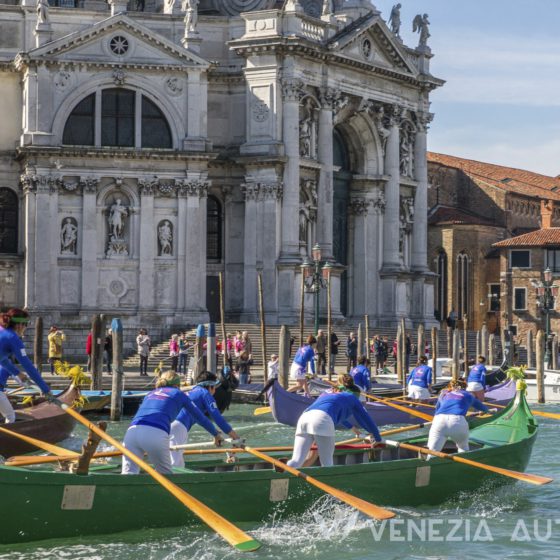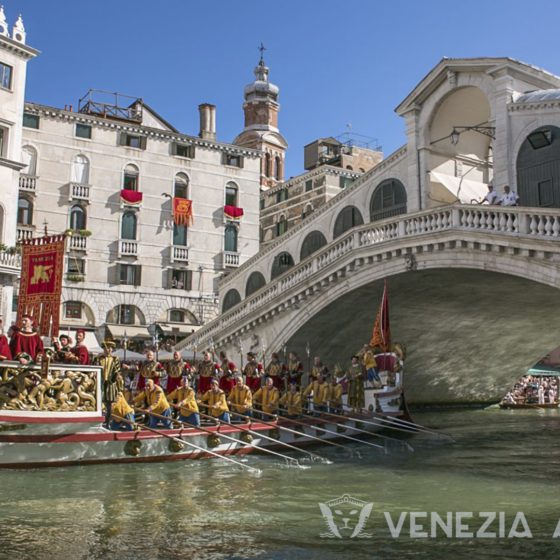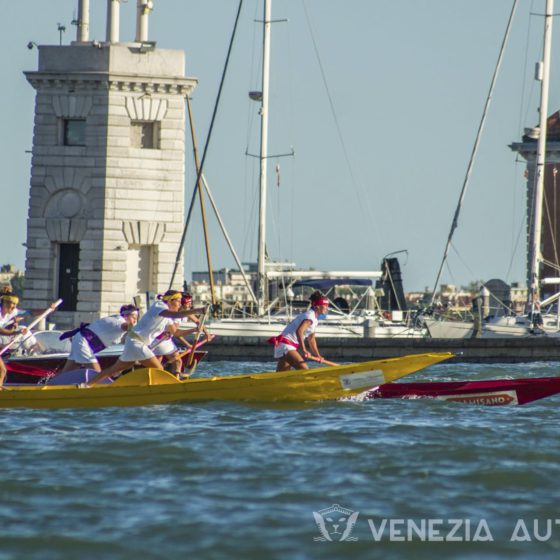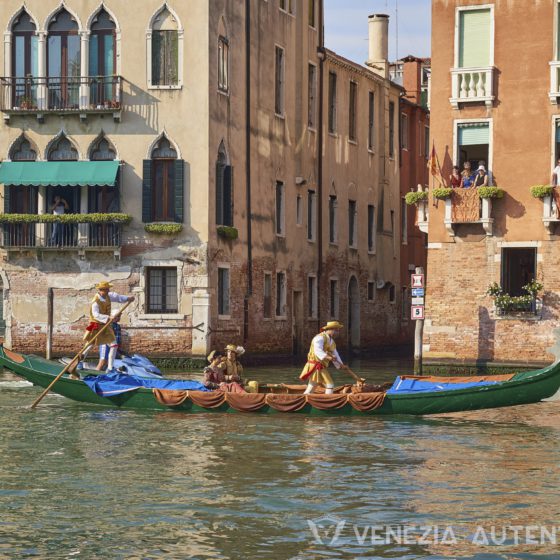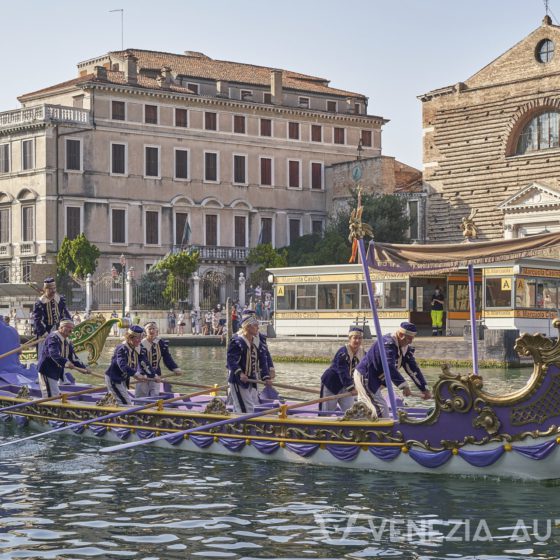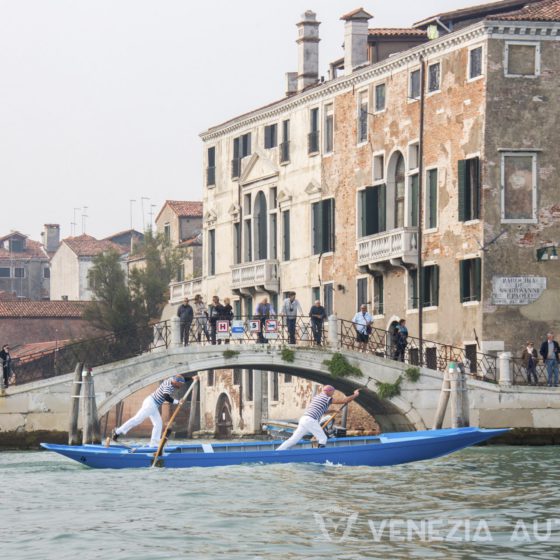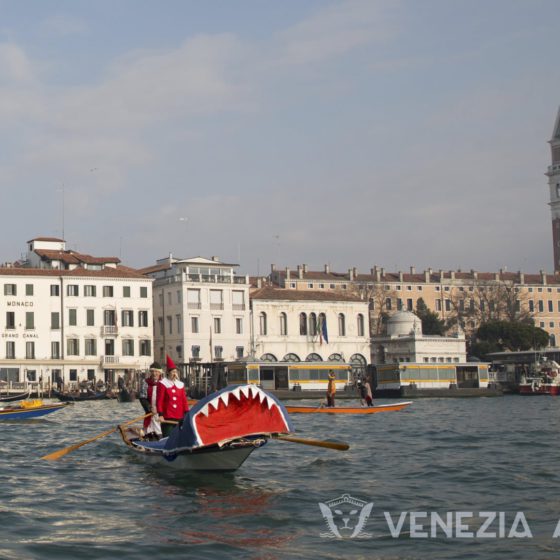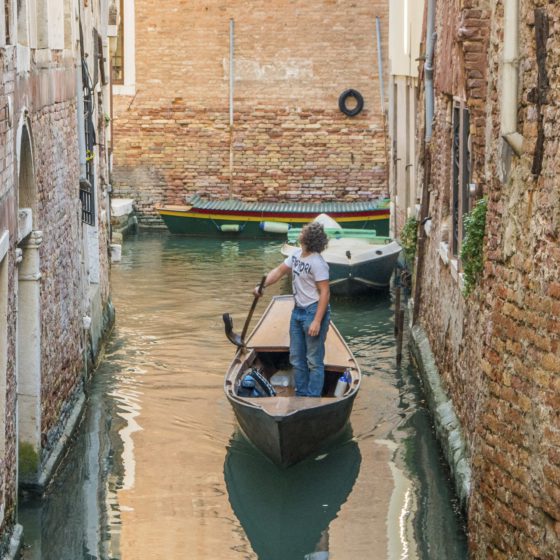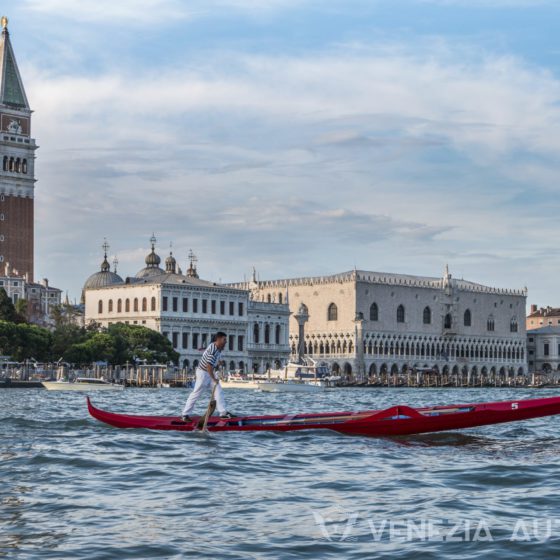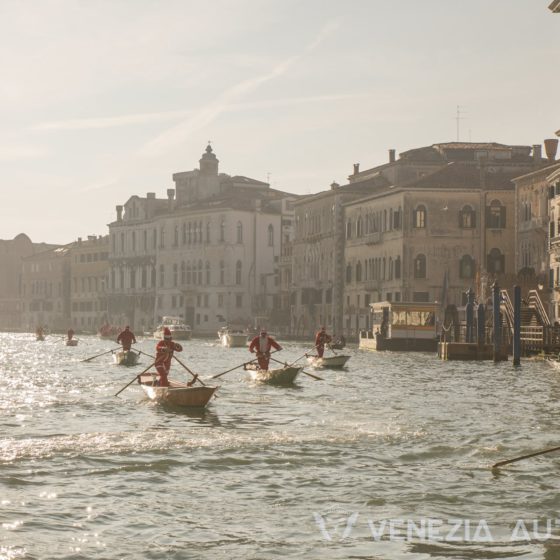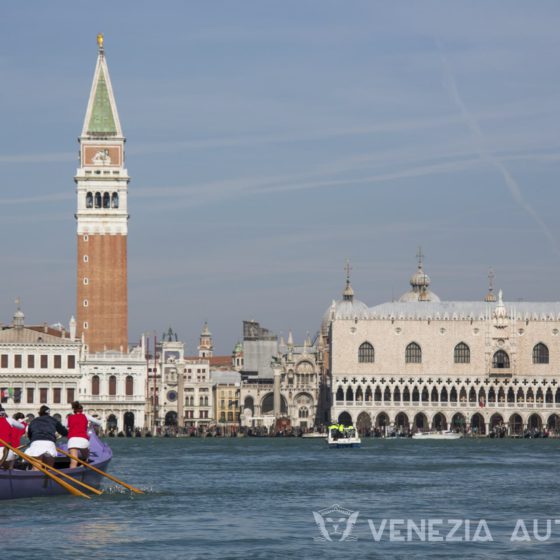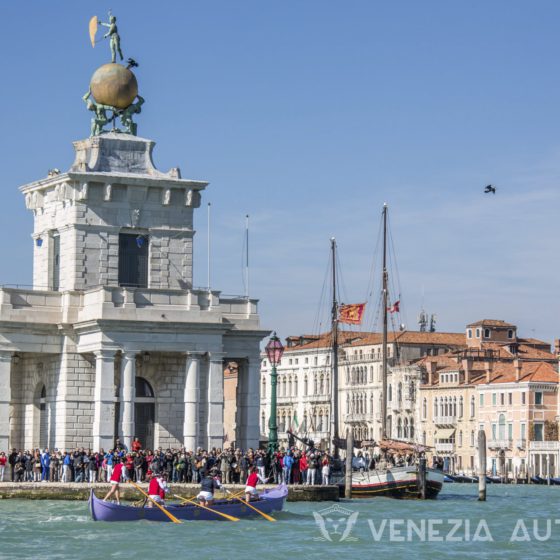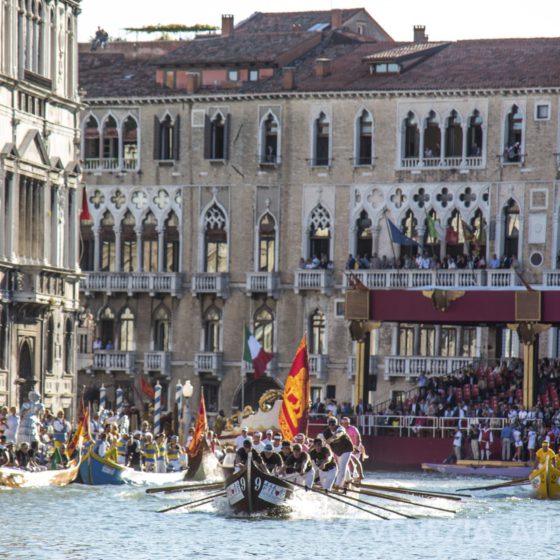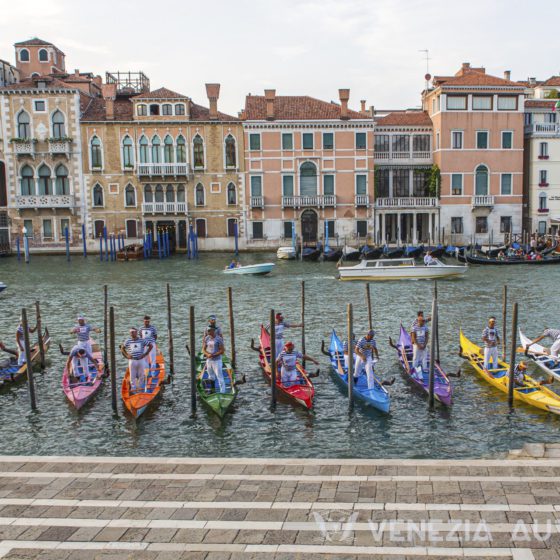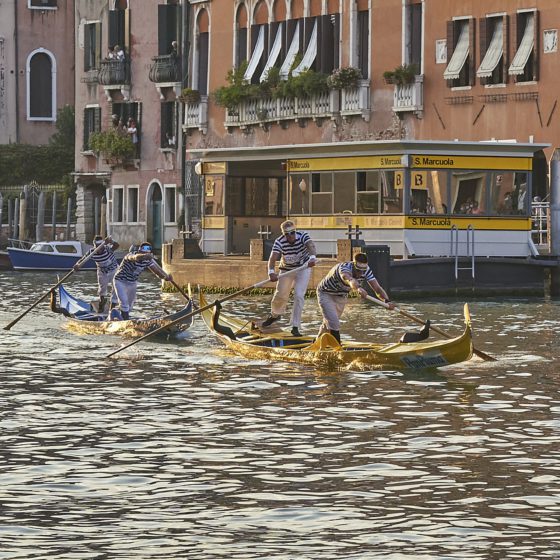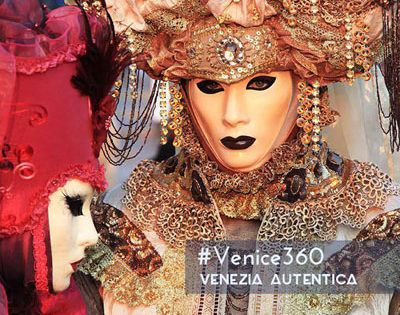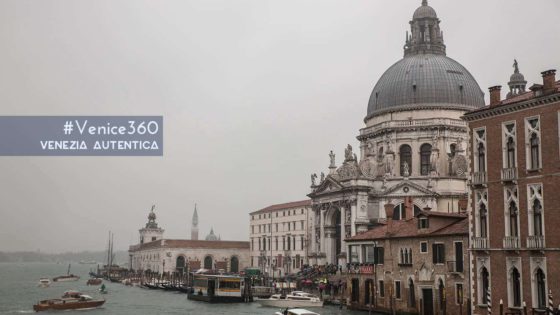Venetian rowing in a nutshell
The “Voga Veneta” or Venetian rowing, is the traditional Venetian rowing technique in which rowers are standing up, facing forward and resting the oar in a special oarlock called “forcola”.
It is a pleasant rowing style not only because it allows you to see where you are going, but because it is extremely efficient. A recent study confirms that to transport three people plus the weight of the boat (half a ton), a gondolier consumes the same amount of energy as he does walking.
Another advantage of this style is the manoeuvrability: the gondolier is able to carry out every manoeuvre – starting off, right-angle turns, slow or sudden stops, moving sideways or backwards – without changing his position.
The different types of Venetian Rowing
There are three types of Venetian rowing: first and foremost the method with a single rower using a single oar (the oar also acting as rudder), a la valesana with a single rower using two crossed oars, and the method with two or more rowers – normally an even number – on alternate sides of the boat. In each case, the most important role is played by the oarsman at the stern.
If you want to know more about Venice in general, check out our “What is Venice, Italy” article!
Advantages and Challenges of the Venetian rowing
The use of a single oar – with the resulting lateral space-saving – is indispensable in the narrow Venetian canals. In fact, when two gondolas arrive from opposite directions, the oar can be passed under the approaching boat, or – as the oar is not ‘closed’ in an oarlock – it can be lifted from the forcola and aligned along the length of the hull. It is obvious, though, that if you row from only one side of the boat, it will go around in circles.
That is why a technique was developed to keep the boat on a straight course.
The stroke can be divided into two phases: the ‘push’ during which the oarsman immerses the blade vertically and pushes on the shaft of the oar, and the ‘return’ in which the oar is moved to its starting point.
After the ‘push’ stroke, the gondolier prepares to straighten the boat with the return stroke.
While the ‘push’ is fairly intuitive, the ‘return’ is a complex movement in which the oar is kept underwater and is brought to its starting point, keeping the forward edge of the blade inclined downwards.
This ‘rudder effect’ is used to correct the boat’s direction.
More about the Venetian rowing technique
Of course, if the return stroke were the equivalent of a reverse push-stroke, the boat would point in the right direction but would not move forward!
Thus every possible technique is used to reduce the ‘braking’ effect of the return stroke and gain the maximum forward motion.
It is no wonder that single-oar regattas are considered the ‘university’ of Venetian rowing: they require strength and stamina, but also technique, style and experience.
As well as the rowing technique, the fact that the boat leans to the right helps to correct the direction.
This deviation is obtained by moving the load (that includes the rowers!), to the right side of the boat.
In the case of the gondola or the “puparin”, even the boat itself is built bent! This way, due to their asymmetric form, these boats tend to naturally turn to the right, counterbalancing the stroke that pushes the boat to its left.
A word about the peculiar Venetian oarlock
The forcola, the beautiful Venetian oarlock, has such a peculiar shape as it gives the rower the possibility of pivoting its oars on different spots.
The oarlock makes it possible to row forward slowly, row forward fast, turn quickly, slow down, row backward, and finally stop the boat.
What else has to be noted is the fact that the “forcola” is not an oarLOCK.
The forcola, in fact, is open, and the oar can be quickly removed from it, making it possible to promptly park the boat or avoid striking other boats with it.
Traditional Venetian Boats
To most tourists who spend just a few hours in Venice, all rowing boats in Venice are gondolas.
However, there are dozens of different types of boats, each of which was developed to respond to a specific need!
The salient characteristics of these boats are:
- The flat bottom that enables the boat to reach the furthest recesses of the very shallow Venetian lagoon;
- The rowing style ‘alla veneta’ where the oarsman faces forwards and uses the characteristic rowlocks (forcole).
- The large oar that also functions as a rudder and can be adjusted to adapt to the depth of the water around the boat.
This is why it’s important to point out that there are indeed plenty of gondolas in Venice, but not every rowing boat is a gondola. Gondolas are a very specific type of boat, that has a precise shape and size.
In other words, calling every boat a gondola would be the same as calling every dog a Doberman.
Gondola and variants
The family of the gondola is vast and varies and, as well as the most well-known type, boats destined for specific uses such as the version for regattas and those used to cross the Grand Canal called barchéta a massoche or da tragheto.
There are also narrower versions such as the gondolin da regata, the gondolìn da fresco, the mussìn, the balotìna, the fisolera, the gondoleta da fresco and the barcheta a coa de gambaro and others that are larger used to represent rowing clubs. The latter have names based on the number of oarsmen they are built to carry: gondolon a otto, diesona (ten oarsmen), dodesona (twelve), quatordesona (fourteen), disdotona (eighteen).
Gondola
The gondola is, without a doubt, the most well-known boat in the world. Even those who have never visited Venice recognize it immediately because of its unmistakable shape, the metal ornament on its bow (ferro di prua), and the unusual style of rowing.
As well as being undeniably elegant, the gondola is perfectly suited to the lagoon environment thanks to a series of solutions that are adopted during its construction. Like all the other lagoon boats it has a flat bottom to allow it to float in very shallow water. The most important feature is its longitudinal asymmetry: the keel is not straight but curves towards the right so that the gondola floats leaning to the right. This counterbalances the propulsion of the single oar which would tend to move the boat to the left.
Its basic measurements are: length between the tops of the posts (measured diagonally): 10.725 m, overall length (including the metal ornaments at the bow and stern): 11.03 m, width between planking 133.5 cm, overall width 143.75 cm, width between planking at the bottom: 96.8 cm, height of construction on the right 50 cm, on the left 52,4 cm, maximum asymmetry taken between the mezzeria and the line joining the posts (with the boat in construction): 20.36 cm.
Sandoli and variants
One of the most widely-used lagoon boats, measuring between 5 and 9 metres, it has a forward-leaning straight stem and a straight transom. There are many variants of the sàndolo to adapt it to a wide range of uses, from fishing (sàndolo a la ciosòta, sàndolo buranèlo, sàndolo sampieròto, sàndolo da fagia), to use as a pleasure craft and for regattas (mascaréta, puparìn), to hunting (s-ciopon), to transporting people (sandolo da barcariol), etc.
Other common boats, Cargo boats and fishing boats
Batela
Batela is a generic name used to describe many types of boat, in this case, it designates a lagoon boat that can be used with oars and sails, without a deck, built in two types: the batèla buranela, and the batèla a cóa de gambaro. The first has a transom, while the second has a rounded stern with an elegantly raised stem. We think that the term barchèta a cóa de gambaro, often used as a synonym, is more slender and more similar to a gondola
Caorlina
The caorlìna is a beautiful lagoon boat, with symmetrical, rounded bow and stern, crescent-shaped stems with vertical ends and parallel sides; the boat is capacious without being ungainly. Only a few examples built to traditional techniques have survived, but many replicas have been made in marine plywood as pleasure boats or for regattas. It can be used both with oars (up to six oarsmen) and with sails. It was used for transport and for a style of fishing known as seràgia, in which case a camaròto (low cabin) was built for the fishermen.
Topo or Batelo da pisso
The topo is a lagoon and coastal boat with a flat bottom, between 6 and 14 metres long. It has rounded sides and stern with a curved vertical stem and a forward-reaching curved bow. Many variations exist which are denominated according to the area of the lagoon they originated in and the use to which they are put: battello a pìsso, mùsso or musséto, topéto, tòpo mistieréto, tòpo venessiàn, batèlo col fìlo. It was used for transport and fishing with oars and lugsails. It is now motorized (mototopo) or with the stern cut straight (topa). The topo is the most widely used lagoon transport boat.
Topa
Currently, the topa is a lagoon boat similar to a mouse but with a mirrored stern instead of a round one, on which an outboard motor can easily be installed. It has had great success thanks to its versatility, as it can easily go by motor, rowing and sailing, so much so that it is also manufactured as standard in fibreglass. The tope are from 6.5 to 7.30 meters long and about 1.70 1.90 wide.
The place of Venetian rowing in local life
Rowing and daily life in Venice
Most of the time, Venetians prefer to move by foot. Moving by foot is the fastest and most efficient mean of transportation in Venice… if you know how to get to your destination of course! Most Venetians use public transportation when necessary, as when water must be crossed. Rowing boats are mainly used for sport or for the pleasure of rowing itself, motorboats are mainly used for transportation of goods and during days off for enjoying the lagoon.
The remiere, rowing clubs, are undoubtedly one of the few places, maybe the best places, for social gathering and interaction between the people living in Venice.
Remiere are one of the last places of social interaction in Venice for the local population
To the rest of the world, the Voga Veneta is the technique used by the Gondolieri, but for the locals, the Voga Veneta means so much more, both for the younger generation and for the older generations, regardless of gender or wealth. It’s unsurprising to see a much older rower teaching or just going out for some healthy activity with a rower who still has some baby teeth.
Since both the techniques and the boats have substantially been unchanged over thousands of years, the Voga Veneta can be seen as one of the strongest ties to the past, as well as a tradition that keeps the city and its citizens’ identity alive, deserving therefore to be protected and promoted just like the remiere are doing.
Women and rowing
The female participation in rowing and regatte faded for several decades after WWII, but in the past 10 years women are becoming every year more active, growing in number, strength and motivation every year, making the female rowers the greatest, and much needed, boom in the rowing world.
Rowing as a competitive sport
An important part of the practice of the people who row for sports are the competitions.
“Regate“, regattas in English, are Voga Veneta races performed on traditional Venetian boats. The first regattas took place in Venice in 942 C.E., over a thousand years ago.
Regate can be divided into two major groups, those organized by the city municipality and those organized by the rowing clubs.
Every year there are a total of 8 “Regate Comunali” organized by the city municipality, which are considered to be “official“, while the number of non-official races is much greater. Together, they create a busy calendar for regata lovers who could easily spend most of their weekends racing or cheering throughout the year.
Experiencing the Venetian rowing as a tourist
There are several ways for you to experience the Venetian rowing and discover Venice from the water, in a slow and delicious way. Whether you are feeling like chilling or getting hands-on, you will find a way that suits you to experience this centuries-old know-how. We list them below
Gondola and sandolo tour
A slow, romantic and ecological way to discover Venice is to be rowed around by an expert rower. Whether you choose a gondola or a sandolo, a ride will take you for a ~25 minutes round trip along the smaller and quieter canals in the surroundings of your starting point.
Gondoliers and sandolisti know their tours well and will usually be able to tell you interesting stories and anecdotes about the area you’re visiting. A gondola can welcome up to 6 people, a sandolo 4 and both have a cost of 80 euros for a 30 minutes tour during the daytime.
Here’s our tip if you’re considering taking a gondola tour: avoid boarding a gondola in the most iconic areas, especially during the busiest months!
The gondola stations at Rialto, San Marco, and Bacino Orseolo are the go-to places of many big tourist groups. You might end up waiting in line for hours before being able to board your gondola, and will spend your tour as part of a “gondola train,” with several other gondolas ahead and behind you.
Instead, take a gondola (or a sandolo) when you see only one or two docked in a little canal.
Related: The gondola is Venice’s most iconic boat: here’s everything you ever wanted to know about it
Take a rowing class
If you are looking for a hands-on experience of the Venetian rowing, An even better alternative to discover and admire Venice from the water, is to take a private Venetian rowing class!
During this unique activity, you will be walked through the basic of the technique and coached while you learn by doing by rowing your boat in Venice canal with the help of an expert rower.
In our opinion, this is an extraordinary way to see Venice from the water, to discover a beautiful residential area of the city, and to try your hands on a traditional activity that is older than Venice itself! You can Book your private 90 min walking tour + 90 min
Attend an event, participate in the celebration of Venetian rowing
Regata Storica
The Regata Storica is the main “Voga alla Veneta” , or Venetian Rowing, event of the year. Today it is internationally known for its spectacular historical parade of XVI century boats and rowers in period costumes.
Besides the evergreen beauty of the boats and the costumes, the Regata Storica is locally much appreciated for its rowing boat races that will see the athletes battling all through the Grand Canal, in an extraordinary context of beauty, history and loud cheering.
The 4 races are divided by type of boats, and category of ages or genders: juniors, women, men on “caorline” and men on “gondolini”.
Festa della Sensa
Festa della Sensa dates back to 1177, when the Pope Alessandro III and the emperor Frederick Redbeard signed the peace bill between the papacy and the emperor. As a propitiatory gesture for this important event, the Doge would throw a gold ring into the lagoon, to celebrate the marriage between Venice and the Sea.
Nowadays, a parade made of traditional Venetian boats, led by the Serenissima boat, rows from San Marco to the Lido and, at the arrival throws a symbolic ring to celebrate once more the eternal tie between Venice and the Sea.
Attend one of the many events on the rowing season calendar
Official regate are competitions for the best Venetian rowers, divided by gender and age, and as such only the strongest, most capable and trained athletes will take part to the qualifiers and possibly compete in the “regata comunale”.
Non-official regate can be very competitive and strict, or they can be held just for fun, or to give a chance also to those who are a bit older, not well trained or have just started rowing.
Some “regate” organized by clubs can be extremely fun to do and stunning or amusing to watch, so we thought of making a shortlist of those that we believe are the most amazing and entertaining to watch.
“Regata della Befana“: every epiphany, on the 6th of January, rowers that are over 60 years old dress up as a “befana”, a sort of old whitch, and compete against each other on the Grand Canal.
“Regata di Carnevale“: on carnival, every man&woman team chooses combined carnival costumes and battles the opponents on Grand Canal. The victory goes to the team that gets the highest score by combining their ranking in the regatta and their ranking in the costume originality. The great costume maker Stefano Nicolao gives the ranking of the costumes.
“Regata dei Babbi Natali“: at the beginning of December, rowers dress up as Santas and compete “alla valesana” (one person per boat, rowing with one oar on each side) on the Grand Canal.
“Regata delle Donne“: every first sunday of march, six women on every “caorlina” compete in this beautiful regata that starts at giudecca and finishes at the Chiesa di Santa Maria della Salute, to celebrate the “International Women’s Day” which is on the 8th of March.

